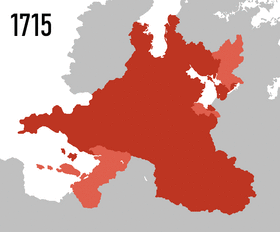Partitions of Cuthland: Difference between revisions
No edit summary |
No edit summary |
||
| Line 34: | Line 34: | ||
==Perspectives== | ==Perspectives== | ||
===Fifth Partition=== | ===Fifth Partition=== | ||
{{Template:Cuthland-Waldrich topics}} | |||
[[Category:Cuthland-Waldrich]] | [[Category:Cuthland-Waldrich]] | ||
[[Category:History of Aurorum]] | [[Category:History of Aurorum]] | ||
Revision as of 06:56, 25 August 2020
| Partitions of Cuthland | |
|---|---|
 Animation showing the territorial evolution of Cuthland during the partitions | |
| Events depicted: | |
| 1715 | Beginning of the War of the Cuthish Succession |
| 1740 | First Partition, end of the War of the Cuthish Succession |
| 1778 | Second Partition, end of the First Cutho-Mascyllary War |
| 1800 | Third Partition, end of the Cuthish Revolutionary War |
| 1825 | Fourth Partition, end of the Karsk Sea War |
The Partitions of Cuthland were a series of territorial concessions imposed on the First Cuthish Empire and its successor states during the 18th and early 19th centuries. The partitions occurred in four stages, beginning with the First Partition following the War of the Cuthish Succession in 1740 and ending with the Fourth Partition following the Karsk Sea War in 1825. Cuthland's partitions provoked an extended era of decline known as the Century of Horrors, resulting in the temporary loss of the nation's great power status and contributing to a period of sociopolitical upheaval brought on by the Cuthish Revolution. The Alhstead Wars of the mid-19th century partially reversed the territorial losses inflicted by the partitions, which would ultimately serve as one of the primary causes of the Great War.
Some historians propose the inclusion of a Fifth Partition of Cuthland, referring to the Treaty of X which ended the Great War and resulted in the cession of many Cuthish territories to neighboring states. This terminology has largely been promoted by Wilfred Drace of the University of Kingsham, whose 1997 article The Five Partitions of Cuthland brought the theory into mainstream academic discussion. However, Drace's thesis has proven controversial and is not widely accepted in the academic community.